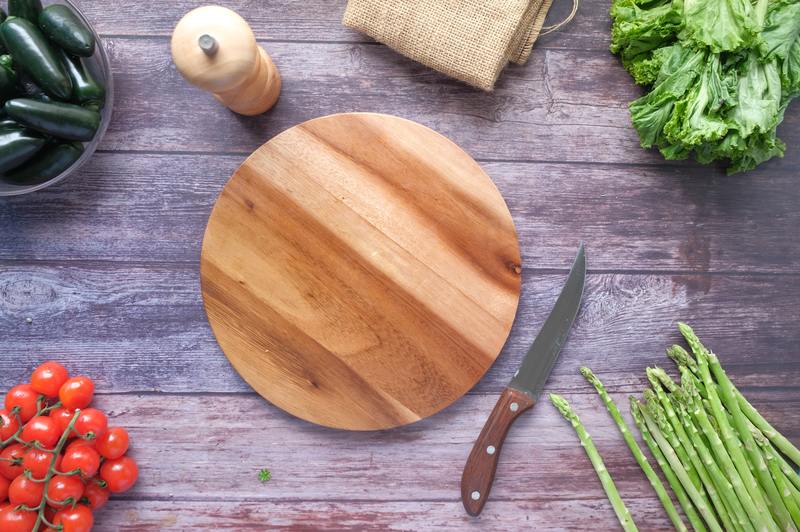To save them, you will need to know how to get mildew smell out cutting boards! Cutting boards are used in food preparation so often that the chances of it having a rancid and mildew smell are pretty high.
Several cleaning hacks are available on the internet that can help you keep your cutting board clean, sanitized, and in perfect working order!

How To Remove Mildew Smell From Cutting Boards
For this, you need to stay true to your main objective. Making sure your board is clean is a given, but your real goal here is to remove the mildew stench out of your cutting board.
You can do both by following these steps!
Step #1. Cleaning and sanitizing
Cleaning and disinfecting can be done at the same time. Try any of these hacks:
Vinegar with baking soda
Vinegar is an acid that can neutralize odors and break down bacteria. Using vinegar and baking soda can be considered a deep cleaning solution that can rid wooden cutting boards of serious bacterial built-in and black stains.
You can begin the cleaning process by washing the cutting board with hot, soapy water. Make sure to rinse thoroughly right after.
Soak paper towels with vinegar, then place them on top of the cutting board for a while. Rinse with water afterward.
For deeper cleaning, sprinkle baking soda on the board. Then, spritz with vinegar before scrubbing with a brush.
You can also let the formula baking soda and vinegar sit for a bit before scrubbing. Make sure to rinse well.
Lemon and salt
A standard natural solution to remove odor and black stains is lemon and salt. This combination is typically used for not-so-severe conditions.
Lemon juice, in particular, is a natural bacteria and germ killer that contains 5% acid. It is a milder cleaning solution that is as effective as bleach in fighting against mold and mildew!
You must first take a towel and soak it in hot water. Wipe down the board with it.
Grab some salt and sprinkle it on top of the board. Squeeze half a lemon over the cutting board.
Wait until the salt dissolves in the juice. Scrub down the cutting board with the lemon for 5 minutes.
Make circular motions while scrubbing and cover every space of the board. Rinse thoroughly and let dry.
Bleach
If natural solutions don’t work, try using a more robust method. A bleach solution can not only help remove the mildew smell, but it could also get rid of stubborn black stains that linger on the surface.
Mix 2 teaspoons of bleach with water (a gallon). Gently scrub down the surfaces of the board using the bleach solution.
Rinse well with clean water, then let dry. Repeat if the smell persists.
Sanding
If all methods prove unsuccessful, try sanding. The original finish might have caught the mildew smell.
By sanding the cutting board, you will remove the finish and let the natural wood breathe.
Use 100-grit sandpaper and gently sand the surface of the board. Make uniform movements to ensure that no part is left uneven.
Sanding comes with a cost since it takes parts off your cutting board. So, only use this as a last resort solution when all other methods fail.
If you have other tools or possessions with a musty stench of mildew, you can read this article to know what kills mildew smell.
Step #2. Drying
No matter which method you choose, make sure to dry the board thoroughly after. Please do not leave it wet.
Use either a paper towel or a dry cloth to dry off the surface. After cleaning and drying, do not lay it flat down on the countertop.
Ensure that it is standing so that the moisture does not get trapped on the board.
Step #3. Conditioning
Wooden cutting boards are likely to dry out if not taken care of. Apply food-grade mineral oil or coconut oil once a month to prevent this from happening.
The oil will penetrate the wood fibers, saturating them in the process. This prevents unwanted liquids from seeping into your cutting board.
Ways To Prevent Mildew Smell From Stinking Up Your Cutting Board
Maintenance is just as essential as cleaning. A well-looked after board can last for years and even decades!
Here is how you can both maintain your board and prevent the smell of mildew!
1. Clean your board regularly
Bacteria, mold, and mildew are quick to grow on cutting boards that are not properly cleaned. You can skim through this article if you want to know how long does it take for mildew to grow.
You need to regularly wash your board with detergent and warm water after every use.
2. Never leave it soaking wet
Unlike pots, utensils, and pans, you should never leave a wooden cutting board soaking wet. It could lead to swelling, cracking, and warping.
3. Keep it oiled
Wooden cutting boards will eventually dry out if not oiled. Be aware that a dried-out board will crack and warp over time.
It is recommended to oil your board at least once a month.
Conclusion
All cutting boards have the potential to smell like mildew. Leaving it be is highly unhygienic, not to mention that it is a definite health hazard.
Fortunately, the steps on how to get mildew smell out cutting boards are simple enough to follow!
